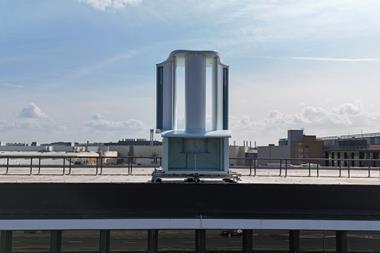BMW’s Dr. Irene Feige, Head of Climate Strategy and Circular Economy says that circular economy is becoming central to BMW’s automotive production landscape, part of its wider push for sustainable production and supply chains.

Necessity is the mother of invention, and the obligation brought about by growing sustainability efforts are synthesising once-disparate areas of automotive production into a single holistic ecosystem. The impulse is towards convergence. The term ‘ecosystem’ is, far from being a platitude, an apt metaphor for a system where a change in one of its parts automatically affects the entire edifice. This is exactly what is unfolding in automotive production. As OEMs put their heads together to find sustainable solutions they are discovering that sustainable production is inseparable from circularity, and that the latter inevitably depends on key aspects of design and engineering.
A leading example: by 2027 BMW’s principal Munich facility will exclusively produce electric vehicles (EVs); undergoing extensive renovations for heightened efficiency and digital integration, (electrification, meets manufacturing engineering – meets digitalisation). Serial production of an electric sedan, based on the group’s latest EV-centric architecture, the Neue Klasse, is set to commence in 2026, following a €650 million ($715 million) overhaul.
With BMW aiming to reduce manufacturing costs by 25% for the Neue Klasse architecture compared to 2019 levels, the integration of manufacturing, design and engineering, (particularly in material decision-making processes) are crucial, according BMW executives.
Oversight of BMW’s sustainable strategic roadmap
On the circular economy side, Dr. Irene Feige, Head of Climate Strategy and Circular Economy, is engaged in setting the strategic roadmap for making BMW’s automotive products more sustainable. Within BMW Group, Feige has held various positions in corporate strategy and stakeholder management, and is perfectly placed to take BMW out into the green fields of automotive production. She highlights that BMW’s global team works across the entire lifecycle of its vehicles to realise carbon neutrality and circularity. “The transition to a circular economy is a fundamental shift for the BMW Group, and represents a core component of our sustainability strategy and future product development,” she says.
“From 2025 onwards, we are ramping up electrification with the introduction of our Neue Klasse range of cars, which will have a new generation of battery and a trailblazing approach to both the use of recycled parts and vehicle recyclability.”
The Neue Klasse range will also set new standards for BMW’s work on digitalisation and electrification, and will include a new concept that will allow the carmaker to tailor-make batteries to fit any model, as well as introduce new component recycling techniques.
Feige says, “BMW’s guiding principle is the circular economy, which we define as ‘Design for Circularity’. We are on a mission to use raw materials responsibly and to reduce the CO2 emissions resulting from their extraction and processing. Where possible, we opt for secondary materials.” Feige feels that transparency about the use of materials along the entire value chain is the basic requirement for further savings. “Digitalisation provides fundamental technologies to create this transparency,” she says.
Circular resources and material selections for vehicle production
Feige says BMW recognises that the future of the planet depends on a transition to net-zero emissions and a circular economy. “That is why we are developing new ways to build cars that use raw materials efficiently: by giving priority to the use of recycled materials and minimising the use of raw materials for automotive manufacturing,” she says. The OEM is primarily looking at aluminium, steel, high-voltage batteries and plastics, to bring this about. “But the world has limited resources,” says Feige, “and this is why our guiding principle for the circular economy is ‘Design for Circularity.’ We take responsible material consumption seriously and are developing new approaches to material use.”
BMW’s focus is on using recyclable materials, reducing CO2 emissions and introducing resource-efficient production methods. It also ensures optimal sorting, dismantling and recycling processes at the end of a vehicle’s use. Across its portfolio, BMW uses around 25% secondary raw material content of steel, up to 20% of thermoplastics, and up to 50% of aluminium for selected components.
BMW knows that successful sustainability depends on the convergence of Design, Production and Research & Development…

Develop your automotive manufacturing understanding by attending DESIGN4PRODUCTION 2024.
Join us on May 15 in Munich, Germany, to collaborate with leading designers, engineers and vehicle manufacturers, and gain a competitive edge in automotive design, development, and production.
JOIN US IN MUNICH AND MEET LEADING PRODUCTION EXPERTS IN THE FIELD | BOOK YOUR SEATS NOW
The BMW i Vision Circular: testing grounds preparing for launch
“As a vision vehicle,” says Feige, “our BMW i Vision Circular embodies how we imagine the recyclable car of the future.” Circularity is the basic idea running through every aspect of its vehicle creation process, beginning with design; where the number of components and materials used is reduced to a minimum.

At the same time, the design is optimised for closed-loop material cycles, which means the vision vehicle is built from 100 percent recycled or renewable materials and is fully recyclable.
Circularity and digitalisation complement each other in the BMW i Vision Circular – for example, with digitally augmented and smart interior surfaces to replace conventional operating controls. From 2025 onwards, the Neue Klasse will take “next level circular approaches” of the BMW i Vision Circular, and put them into practice. “It’s an exciting time,” says Feige.
iFactory, Car2Car and Catena-X: Connecting sustainable production processes and supply chains
If we are looking at supply chain and production in particular, BMW’s ‘Secondary First’ approach aims to increase the percentage of high-quality secondary materials in its vehicles over time. These tend to generate lower CO2 emissions while reducing the carmaker’s dependence on critical raw materials.
BMW is also leading the consortium behind the Car2Car project, which is working with representatives of the recycling industry, commodity processors and academia in the circular economy field, to improve the quality of the secondary raw materials obtained from recycling end-of-life vehicles. The focus is on the materials - aluminium, steel, glass, copper, and plastic. Innovative disassembly and automated sorting methods should enable recoverable materials from the recycling of end-of-life vehicles, to be used much more widely than before in production of new vehicles moving forwards. The consortia project will receive €6.4 million in funding from the German Federal Ministry for Economics and Climate Action as part of its ‘New Vehicle and System Technologies’ programme.
“Collaboration is key and we’re working closely with our suppliers to ensure these materials are available in sufficient quantities and to a high quality,” says Feige, “supported by the cross-sector data ecosystem Catena-X”. Market participants can use this platform to share all relevant data for the circular economy, ensuring a more efficient, circular flow of materials.
BMW’s global production network is already a model of resource efficiency. It began gradually making it’s vehicle production more resource-efficient early on. Year after year, the carmaker has been able to reduce the volume of waste per vehicle, as well as its water and energy consumption. It relies on recycling concepts that are tailored to waste-flows at the plants, the region’s legal requirements, and the disposal structures available at the site in question. With the BMW iFactory, its global strategy for efficient, more environmentally-compatible and digital production, BMW is taking the next step towards circular production. This includes advancing the digital sorting of production waste.
Electromobility the main driver for circular economies?
“BMW has defined circularity as a strategic focus area,” says Feige. “Our goal is to gradually bring the company closer to the ideal of the circular economy. From the increased use of secondary materials for parts and components, to the effective recycling of end-of-life vehicles, we are targeting the entire value chain — Design for Circularity.
“Through our own venture capital fund, BMW i Ventures, we also invest in start-ups that drive a variety of circular solutions.”
Feige emphasises that BMW is committed to the Paris Climate Agreement and following a course aimed at reducing CO2 and limiting global warming to a maximum of 1.5 degrees. It is the first German automotive manufacturer to join the ‘Business Ambition for 1.5° C’ campaign launched by the Science-Based Targets Initiative (SBTi). “This makes us part of the international Race to Zero initiative,” she says. “We firmly believe that effective climate protection can be achieved through technological innovations.”
By 2030, BMW is confident that it will reduce CO2 emissions per car, per kilometre driven, by half from 2019 levels. Throughout the lifecycle – from the supply chain, through production, to the end of the use phase – it is set to achieve a 40% reduction in CO2 emissions.
Feige says, “the main driver for this is electromobility, which will ramp up further with the introduction of our Neue Klasse from 2025 onwards.” With this range of products, BMW already aims to have more than two million fully-electric vehicles on the roads by the end of 2025, and around ten million on the roads by the end of the decade.
“But,“ says Feige, “sustainability is about more than that: the future of our planet demands a circular economy. Every year, humans consume more than 100 billion tonnes of raw materials. We have to counter this – for environmental, economic and social reasons.” And this means modifying the design process, using resources more efficiently and closing material loops. This is another area where BMW sets itself goals. “For instance, we aim to increase the percentage of secondary material in our vehicles to up to 50% going forward,” she concludes. This will require a significant increase in market availability of such materials. One of the ways BMW is aiming to achieve this, is through working with partners across all sectors, an example that should be given serious consideration for all automotive OEMs.
Topics
- Aluminium
- Automation and Digitalisation
- Automotive materials
- Battery System and Pack Production
- BMW
- Design for Manufacturing
- Digitalisation
- Editors Pick
- Electrification
- Europe
- EV component manufacturing
- EV manufacturing
- Industry 4 and Smart Factory
- Kaizen
- Manufacturing engineering
- Materials
- Materials
- OEMs
- Recycling
- Regions
- Renewables
- Smart Factory
- Steel
- Sustainable production
- Sustainable strategies






































No comments yet